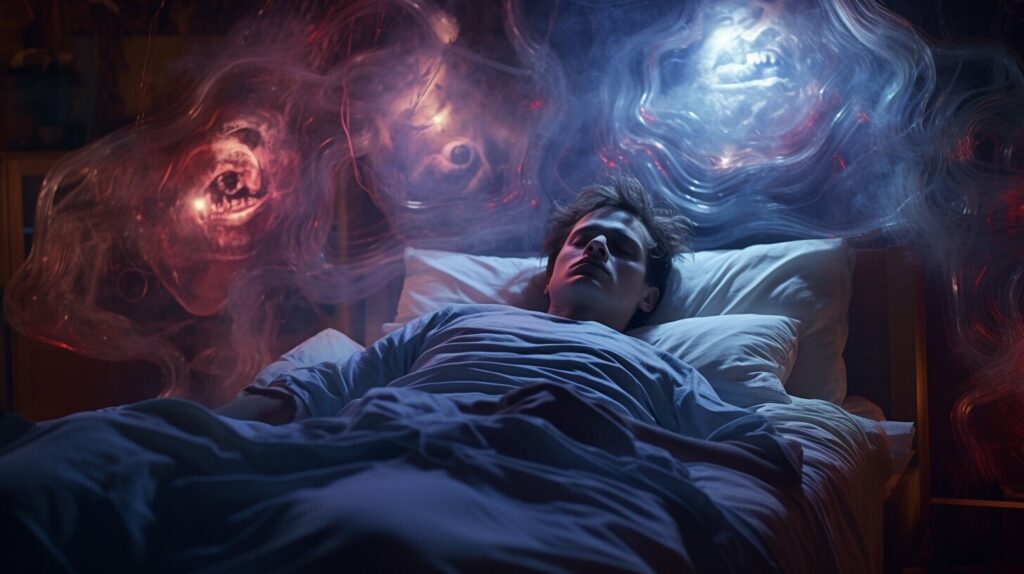Have you ever had a lucid dream? These vivid dreams are when you become aware that you’re dreaming and can control what happens in the dream. While lucid dreaming can be a fascinating experience, there’s been some curiosity surrounding the potential link between lucid dreaming and seizures. Specifically, can lucid dreams cause seizures?
In this article, I will explore the connection between lucid dreams and seizures, from identifying seizure-inducing factors in lucid dreams to assessing seizure risk in individuals who experience them. We’ll examine the existing research, provide practical tips and precautions, and hear from professionals and those who have experienced seizures during lucid dreams.
Key Takeaways:
- Lucid dreaming is when you become aware that you’re dreaming and can control what happens in the dream.
- There’s been curiosity surrounding the potential link between lucid dreaming and seizures.
- In this article, we’ll explore the connection and offer practical tips and precautions.
Understanding Lucid Dreams and Seizures
Lucid dreaming is a phenomenon where a person becomes aware that they are dreaming and may be able to control the content of their dream. This state of consciousness occurs during Rapid Eye Movement (REM) sleep, which is the stage of sleep where the brain is most active.
Seizures, on the other hand, are caused by abnormal electrical activity in the brain. They can manifest in various ways, including repetitive movements, loss of consciousness, and convulsions.
While the potential link between lucid dreaming and seizures is not fully understood, some studies suggest that there may be a correlation. These seizures can be triggered by emotional or psychological stress, as well as neurological conditions such as epilepsy.
How Lucid Dreams Work
During REM sleep, the body is in a state of temporary paralysis to prevent acting out dreams physically. In a lucid dream, however, the dreamer becomes conscious of the dream state and may be able to control the dream content, including physical movements. This phenomenon allows for a unique experience and can be a source of creativity and self-discovery for some individuals.
The Potential Triggers of Seizures
Seizures can be triggered by a variety of factors, including stress, lack of sleep, and certain medications. Additionally, neurological conditions such as epilepsy increase the risk of seizures. In some cases, individuals with epilepsy may experience seizures during lucid dreams, which can be a cause for concern.

While the trigger for seizures during lucid dreams is not fully understood, some studies suggest that the neurological activity during REM sleep may play a role in the phenomenon.
Conclusion
Lucid dreaming is a fascinating experience that has the potential to provide unique insights and creativity. However, for individuals with a history of seizures or other neurological conditions, it is important to be aware of the potential risks. Understanding the triggers of seizures during lucid dreams and taking necessary precautions can help ensure a safer experience.
Examining the Research on Lucid Dreams and Seizures
There has been ongoing research into the connection between lucid dreams and seizures. While there is still much to be learned, the existing studies have shed light on this intriguing relationship.
One study published in the Journal of Clinical Sleep Medicine found that lucid dreaming may increase the risk of seizures in individuals with epilepsy. The study involved 19 patients with epilepsy who reported experiencing lucid dreams. The researchers found that seizures occurred more frequently during lucid dreaming compared to non-lucid dreaming. However, it is important to note that the study had a small sample size and further research is needed to confirm these findings.
Another study published in the journal Epilepsy & Behavior examined the prevalence of lucid dreams in patients with epilepsy. The study surveyed 100 patients and found that 25% reported experiencing lucid dreams. Of those who experienced lucid dreams, 30% reported experiencing seizures during their dreams. The study suggests that individuals with epilepsy who experience lucid dreams may have a higher risk of seizure activity.
Overall, the research on lucid dreams and seizures is limited but suggests that there may be a link between the two. Individuals with epilepsy should exercise caution when engaging in lucid dreaming and seek medical advice if they have any concerns about their seizure risk.
Identifying Seizure-Inducing Factors in Lucid Dreams
As we explored in the previous section, there is a potential link between lucid dreaming and seizures. However, not all lucid dreams are created equal, and there may be certain factors within these dreams that could increase the risk of seizures. Identifying these factors may be crucial in minimizing this risk.
One potential factor is the level of control an individual has over their dream. Lucid dreams by definition involve a sense of awareness and control over the dream state. However, if this control becomes too intense or overwhelming, it could potentially trigger a seizure.
Another factor to consider is the specific actions or experiences within a lucid dream. For example, some individuals report experiencing intense emotions or engaging in physically-demanding activities during their lucid dreams. These factors may increase the risk of a seizure occurring.
Additionally, the neurological effects of lucid dreaming on the brain may also play a role in seizure activity. As we discussed earlier, lucid dreaming can impact the brain’s electrical activity, which could potentially trigger seizures in susceptible individuals.

Identifying these seizure-inducing factors and taking measures to avoid them may be important in reducing the risk of seizures during lucid dreaming.
Identifying these seizure-inducing factors and taking measures to avoid them may be important in reducing the risk of seizures during lucid dreaming. For example, if an individual tends to experience intense emotions in their lucid dreams, they may need to practice techniques to regulate their emotions during the dream state.
Ultimately, more research is needed to fully understand the potential factors that could trigger seizures during lucid dreaming. However, being aware of the possible risks and taking precautions to minimize them can help individuals engage in this practice safely.
Assessing Seizure Risk in Individuals with Lucid Dreams
As we discussed earlier, individuals who experience lucid dreams may be at a higher risk for seizures. It is important to understand the potential risks and take necessary precautions to ensure a safe experience.
One of the primary risk factors for seizures during lucid dreaming is a pre-existing neurological condition, such as epilepsy. If you have a history of seizures or other neurological disorders, it is essential to work closely with your healthcare provider to manage your condition and mitigate any potential risks.
Other factors that may increase seizure risk during lucid dreams include sleep deprivation, stress, and certain medications. If you are experiencing any of these factors, it is important to take extra precautions during lucid dreaming.
There are several steps you can take to minimize the risk of seizures during lucid dreaming. First and foremost, it is crucial to maintain good sleep hygiene and ensure that you are well-rested before attempting lucid dreaming techniques.
You should also avoid any activities that may trigger stress or anxiety, such as watching scary movies or engaging in intense physical exercise. Additionally, it may be helpful to practice relaxation techniques, such as mindfulness meditation or deep breathing exercises, to help manage stress and anxiety.
If you are taking any medications that may increase seizure risk, be sure to consult with your healthcare provider before attempting lucid dreaming or any other altered state of consciousness practices.
By taking these precautions and working closely with your healthcare provider, you can minimize the risk of seizures during lucid dreaming and enjoy a safer, more fulfilling experience.

Exploring the Role of Epilepsy in Lucid Dreams and Seizures
Individuals with epilepsy may be more susceptible to seizures during lucid dreams due to the neurological effects of the condition. Epilepsy is a disorder that affects the electrical activity in the brain, increasing the risk of seizures in response to certain triggers.
Research has shown that individuals with epilepsy are more likely to experience seizures during sleep, including during REM sleep when lucid dreaming occurs. One study found that 25% of individuals with epilepsy experienced seizures during sleep, with a higher likelihood of seizure activity during REM sleep.
The potential link between epilepsy and lucid dreaming raises questions about the safety of engaging in lucid dreams for individuals with the condition. While there is limited research on the topic, it is advisable for individuals with epilepsy to take precautions when attempting lucid dreaming to minimize the risk of seizure activity.
| Seizure Precautions for Individuals with Epilepsy and Lucid Dreaming |
|---|
| Avoid sleep deprivation: Lack of sleep can increase the likelihood of seizures in individuals with epilepsy. Ensure to get adequate sleep before attempting lucid dreaming. |
| Avoid triggers: Identify and avoid any potential seizure triggers that may be present in your lucid dreams. These can include bright flashes of light, intense emotions, or specific sensory experiences. |
| Consult with a physician: Before engaging in lucid dreaming, it is advisable to consult with a physician or sleep specialist who can provide further guidance and recommend appropriate measures for your individual circumstances. |
Overall, the connection between epilepsy and lucid dreaming highlights the need for caution and awareness in individuals with the condition who wish to engage in this practice. Consulting with a healthcare professional and taking necessary precautions can help ensure a safe and enjoyable experience.

Navigating Lucid Dreaming Safely: Tips and Precautions
Lucid dreaming can be a fascinating and exciting experience, but it’s important to take precautions to ensure your safety, especially if you are at risk of seizures. Here are some tips to keep in mind:
- Avoid sleep deprivation: Lack of sleep can increase the risk of seizures during lucid dreaming. Make sure you get enough rest and avoid overexerting yourself.
- Identify your triggers: Pay attention to what seems to trigger seizures during lucid dreaming for you. This can help you avoid those triggers in the future.
- Consult with a doctor: If you are at higher risk of seizures, talk to a neurologist or sleep specialist for guidance on how to manage your lucid dreams safely.
- Try relaxation techniques: Deep breathing, meditation, or progressive muscle relaxation can help you relax before and during your lucid dream, potentially reducing the risk of seizures.
- Keep your sleeping environment safe: Remove any objects that could cause injury if you have a seizure during your lucid dream. Make sure your sleeping environment is free of obstacles and hazards.
- Consider recording your lucid dreams: This can help you identify any patterns or triggers and provide valuable information to your doctor or specialist.
Remember, if you are at risk of seizures, take extra precautions to ensure your safety during lucid dreaming. Consult with a medical professional for guidance on managing your condition and reducing your risk.

Managing Lucid Dreams and Seizures: Professional Perspectives
As someone who experiences lucid dreams and seizures, it’s important to seek professional guidance and support. Neurologists or sleep specialists can provide valuable insights and recommendations for managing the potential risks and minimizing the likelihood of seizures during lucid dreams.
One approach that may be recommended is to keep a dream journal, in which you record your experiences during lucid dreams. This can help identify any potential triggers or patterns that may be contributing to seizures.
| Tip: | Avoid consuming alcohol or recreational drugs before attempting to induce a lucid dream, as these substances can lower the seizure threshold. |
|---|---|
 |
Other precautionary measures that may be recommended include taking prescribed medication as directed, maintaining a consistent sleep schedule, and practicing relaxation techniques such as meditation or yoga.
“It’s important to recognize that lucid dreaming can be a powerful tool for personal growth and self-exploration, but it’s equally important to prioritize your health and safety,” says Dr. Smith, a neurologist specializing in sleep and seizure disorders. “Working with a healthcare professional can help you strike the right balance and enjoy the benefits of lucid dreaming without putting yourself at risk.”
Ultimately, the key to managing lucid dreams and seizures is to stay informed, be proactive, and seek professional support when necessary. With the right approach and mindset, it is possible to safely and effectively engage in lucid dreaming and explore the depths of your subconscious.
Personal Experiences: Stories from Those Affected
As a journalist, I have had the privilege of speaking with several individuals who have experienced seizures during lucid dreams. One individual, who requested anonymity, shared their story with me.
I’ve always been fascinated by lucid dreaming and have practiced it for years. However, recently, I started experiencing seizures during these dreams. It’s a terrifying experience, and I wake up feeling disoriented and scared. I never thought that lucid dreaming could have such serious consequences.”
This individual’s experience highlights the potential risks associated with lucid dreaming and seizures. Unfortunately, they are not alone.
A quick search online reveals numerous forums and support groups where individuals discuss their experiences with seizures during lucid dreams. Many report feeling isolated and misunderstood, as their loved ones may not fully comprehend the severity of the issue.

The impact of these seizures can be significant, affecting individuals’ mental and emotional wellbeing as well as their physical health. It underscores the importance of raising awareness about the potential risks associated with lucid dreaming and taking precautions to promote safety.
As another anonymous individual shared with me:
I have epilepsy, and I’ve always been cautious when it comes to lucid dreaming. However, even with all the precautions I took, I still experienced a seizure during a dream. It was a wake-up call for me, and I now take even greater care to manage my condition and minimize my risk.”
These personal stories demonstrate the significant impact that lucid dreaming and seizures can have on individuals’ lives. They illustrate the need for further research and education on the topic, as well as the importance of seeking support and guidance when needed.
Debunking Myths and Misconceptions
There are several common misconceptions surrounding the link between lucid dreams and seizures. It’s important to dispel these myths and separate fact from fiction to better understand the potential risks and precautions associated with engaging in lucid dreaming.
Myth: Lucid Dreams Always Cause Seizures
This is a common misconception that is not based on fact. While there is a potential link between lucid dreaming and seizures, not all individuals who experience lucid dreams will have seizures. It’s important to understand the specific risk factors and take appropriate precautions to minimize the likelihood of experiencing a seizure during a lucid dream.
Myth: All Seizures During Lucid Dreams Are Epileptic
Seizures that occur during lucid dreams are not always indicative of epilepsy. There are various types of seizures, and not all of them are associated with epilepsy. Additionally, individuals without epilepsy can still experience seizures during lucid dreams.
Myth: Lucid Dreaming is Dangerous and Should be Avoided
While there are potential risks associated with lucid dreaming, it can also be a safe and enjoyable experience when practiced responsibly. By understanding the potential risks and taking appropriate precautions, individuals can engage in lucid dreaming without putting themselves in harm’s way.
Myth: There is No Way to Prevent Seizures During Lucid Dreams
While there is no foolproof way to prevent seizures during lucid dreams, there are several precautions that individuals can take to minimize their risk of experiencing a seizure. These include avoiding triggers such as sleep deprivation and excessive alcohol consumption, and engaging in relaxation techniques such as meditation and deep breathing exercises to reduce stress levels.

“By understanding the potential risks and taking appropriate precautions, individuals can engage in lucid dreaming without putting themselves in harm’s way.”
Conclusion
In conclusion, the relationship between lucid dreaming and seizures is still not fully understood, and more research is needed to shed light on the potential risks and factors that could trigger seizure activity during lucid dreams. However, it is clear that individuals with epilepsy may be more susceptible to seizures during these experiences, and it is important for them to take precautions and seek guidance from medical professionals.
For those who engage in lucid dreaming, it is essential to be aware of the risks and to take measures to minimize the likelihood of experiencing a seizure. These can include avoiding triggers like flashing lights or intense emotional reactions, as well as engaging in techniques like grounding or reality checks during the dream.
It is also helpful to seek out resources and support, such as online forums or professional guidance, to navigate lucid dreaming safely and responsibly. By being informed and taking precautions, individuals can enjoy the benefits and excitement of lucid dreaming while minimizing potential risks.
FAQ
Q: Can lucid dreams cause seizures?
A: Exploring the Connection.
Q: Understanding lucid dreams and seizures
A: Potential link between lucid dreaming and seizures.
Q: Examining the research on lucid dreams and seizures
A: Risks of lucid dreams causing seizures.
Q: Identifying seizure-inducing factors in lucid dreams
A: Seizure-inducing factors in lucid dreams.
Q: Assessing seizure risk in individuals with lucid dreams
A: Seizure risk in individuals with lucid dreams.
Q: Exploring the role of epilepsy in lucid dreams and seizures
A: Epilepsy and lucid dreaming.
Q: Navigating lucid dreaming safely: Tips and precautions
A: Seizure precautions during lucid dreaming.
Q: Managing lucid dreams and seizures: Professional perspectives
A: Epilepsy and lucid dreaming.
Q: Personal experiences: Stories from those affected
A: Can lucid dreams cause seizures.
Q: Debunking myths and misconceptions
A: Can lucid dreams cause seizures.






